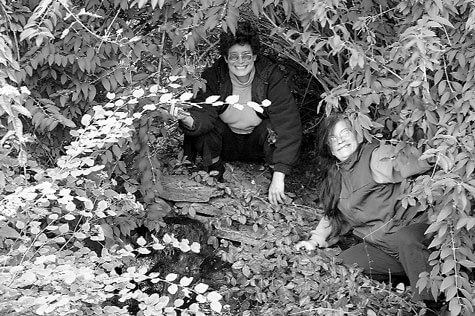VOLUME 3, ISSUE 344 | October 28 – November 3, 2004
NEWS
The Sun Powers City Garden
Couple pioneers solar use in East Village green space
Tracy Fitz, right, and Diana Kline by the new solar-powered waterfall in the East Village’s 6BC community garden.
Environmentally friendly East Village gardeners have just completed building a solar-powered waterfall, and hope to extend the garden’s sun-powered capabilities to lighting, pond oxygenating and more.
The waterfall in the garden, at East Sixth Street between Avenues B and C, has taken ten years to complete and is only the third garden in Manhattan with a solar installation.
Entering the 6BC garden, it is hard to see where the solar panels are mounted. There are a total of six panels, four on the grape arbor, camouflaged by vines and climbing plants, and two on the roof of the garden’s raised library shed’s roof. The 21/2-foot-high waterfall is not immediately apparent either, being hidden by the undergrowth.
The solar facility’s designer, builder and engineer, Tracy Fitz, 55, has also just completed building a second waterfall in another community garden in Brooklyn, where she now lives.
It only takes one of the panels to work the waterfall, but more have been installed to make the 6BC community garden a fully functional solar-powered area.
“The six panels will charge batteries to work lights and tools,” Fitz said. “At the moment, we can charge tools but we can’t run a tool directly from the power for long.”
The solar panels, which cost $400, are made from aluminum, making them lightweight and crack resistant. The panels are able to absorb seven percent of the sun’s energy and are capable of working on cloudy days and in shady areas.
Fitz approached her solar-powered project with no experience at all.
“I used to be a composer,” she explained. “Now I make my money from acupuncture and I eventually hope to make money doing solar power.”
The inspiration for the project came primarily from her grandfather.
“My grandfather was an engineer and architect, so it’s in the genes,” Fitz said.
The influence from her grandfather’s work and a keen interest in water, air and the environment have inspired Fitz to pursue projects that use natural energy. The 6BC garden was the perfect platform for her first design.
Fitz, the treasurer for the nonprofit garden since 1996, thought of building the waterfall when she first became a member of the garden 11 years ago, and met her partner Diana Kline, 49, who was then the garden’s president. Kline also had an interest in solar power, and the two tried to convince funding organizations to get the project up and running.
“We thought we would like to have a waterfall, but we were not on the grid, so it would be good to be solar,” Kline said.
The waterfall itself cost $10,000—not including labor costs—partly funded by the Trust for Public Land and other fundraising efforts.
Fitz educated herself about the project as she went along.
“She figured it out from scratch. What she did is nothing short of phenomenal,” Kline said.
It all started when Fitz made contact with Tom Bishop in Montana, who owns his own solar company, Sunelco.
“He was my mentor,” Fitz said. “He helped and advised me. He told me how to hook it all up. I also bought equipment from him.”
From that starting point, Fitz decided to take a course on solar power at Farmingdale State University of New York and also became a Leadership in Energy and Environmental Design (LEED) professional. The LEED certification program required her to take a comprehensive exam about the environment, architectural design, building use, recycling, water resources and soil erosion.
The 6BC garden’s solar unit is near completion, with only the lighting still to be hooked up for the tool shed and library, which will house books on plants and gardening. The solar facility will also be able to charge tools for the garden, such as grass trimmers.
“We hold concerts, poetry reading and classes in the garden. We can use the electricity to power a loud speaker and lighting,” Fitz said.
Kline feels that having solar power in the community garden will help show people it be can an accessible alternative option to electricity.
“Anybody could walk by and ask ‘What’s that?’ It’s in their mind. They may think solar power is unattainable but then see it in the garden,” Kline said.
Fitz has learned the technology, but she isn’t stopping there. She recently started her own company, City Solar.
“I want to have a solar business that installs rooftop installations for residential and commercial buildings,” she said. “I also want to have a nonprofit organization to help community gardens to get off the grid.”
Fitz and Kline would like to see solar power used more throughout New York, with the city following the lead of Europe, which utilizes all kinds of spaces for mounting solar panels.
“In Europe where gas prices are higher, they have solar panels [on the banks] along the highways,” Fitz said. “We need to make use of horizontal and vertical surfaces. If 24 percent of vertical and horizontal surfaces in New York City are used, we would produce more than enough energy—I think that’s the only way to go to reduce energy consumption.”
For those interested in learning how to incorporate solar power at home, Fitz runs a workshop. For more information, go to citysolar.org or call Tracy Fitz at 718-768-8161.
































